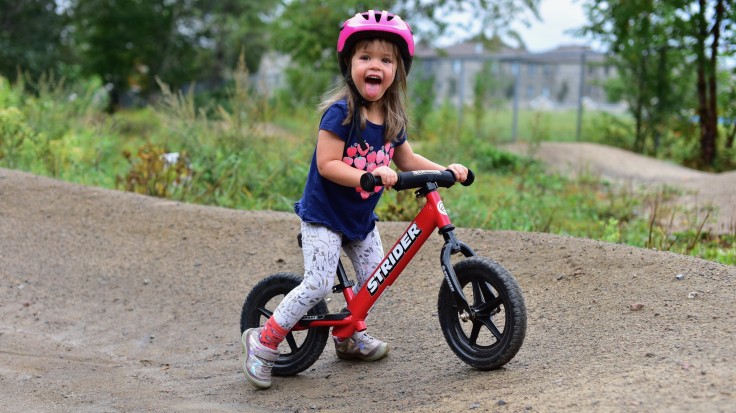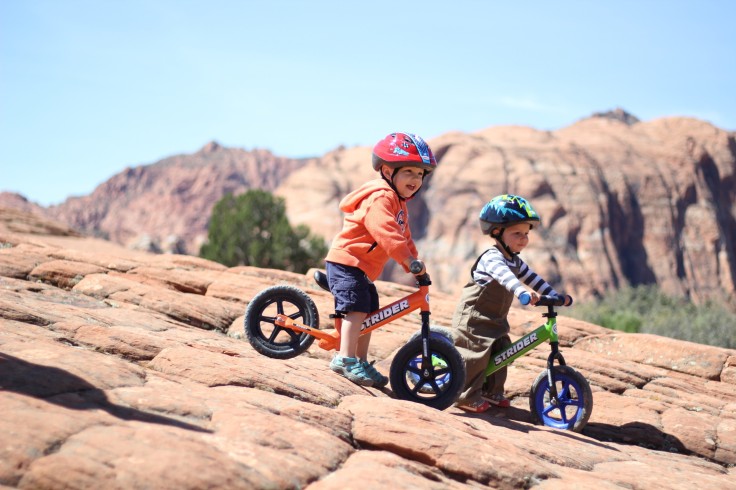Parents eager to support their child's physical development often focus on crawling, climbing, or stacking blocks. But another skill's often overlooked: balancing. Sure, every parent supports their child's balance progression when they start to walk, but they often forget about the importance of developing that skill when it comes to choosing ride-on toys.
Not all ride-on toys support motor skills equally, and some of the most popular ones might even be counter-productive to motor skill development. Tricycles and training wheels, for example, delay important foundational balance skills that help kids graduate to real bike riding. If the ultimate stage of this progression is riding on two wheels, why would kids start on three or four? Starting on two wheels, on a balance bike, engages a child's full body and mind, encouraging coordination, core strength, and confidence from the very start.
Why Balance Is the Foundation of Movement

In early childhood development, balance isn't just a biking skill. When a child learns to shift weight, adjust posture, and move with control, they're building the foundation for more complex motor tasks like running, jumping, and eventually pedaling.
That's where balance bikes shine. Unlike tricycles or bikes with training wheels, balance bikes allow children to practice:
- Weight shifting
- Bilateral coordination (using both sides of the body together)
- Postural control and stability
- Spatial awareness and visual tracking
Because there are no pedals, the child is fully in charge of their movement. They push off, glide, and stop with their feet. They learn to balance naturally.
The Problem with Tricycles and Training Wheels
Though popular, three- and four-wheeled bikes often give a false sense of security.
Tricycles may seem safe, but are surprisingly easy to tip over when turning. They're also heavy, usually twice the weight of a good balance bike, and harder for toddlers to maneuver. Most are built for flat indoor or paved surfaces, which limits exploration and the physical benefits of outdoor play.
Four-wheeled "baby bikes" can be even more misleading. Many are marketed as balance bikes, but the presence of four wheels allows the bike to stand on its own. That means kids don't actually have to balance. And training wheels, of course, also have four wheels, which further limit a child's balance progress.
In all these cases, children often learn to rely on stability aids instead of building true balance and body awareness.
What Science and Experience Show
Early motor development sets the foundation for lifelong physical confidence and control. Balance bikes play a crucial role in this progression by encouraging children to initiate movement and develop coordination independently. Research supports this: a retrospective study found children using balance bikes achieved independent cycling about 1.8 years earlier than those who started with training wheels.
That's because training wheels stabilize the bike in a way that prevents a child from learning how to lean and countersteer—key components of balance. This often leads to bad habits that must be unlearned later.
A controlled trial in Portugal further highlighted the benefits: after just five weeks, 100% of children using balance bikes reached independent cycling milestones, compared to 76.9% of those on training-wheel bikes.
A Smarter Progression: Rock, Stride, Glide, Pedal

The best ride-on toys are those that support children through multiple stages of development. A well-designed balance bike does exactly that.
One of the brands that popularized this kind of staged learning is Strider Bikes, whose line of balance bikes has taught over 10 million kids in 75+ countries how to ride. Their bikes are designed to grow with your child. Their Strider 2-in-1 Rocking Bike starts as a rocker for infants and then transitions into a toddler's first balance bike simply by removing the rocking base. The Strider 12 Sport and Strider 12 Pro, the brand's flagship balance bikes (which the rocking bike is made with), are also sold separately and are famous for their durability.
Many Strider families say their 12" balance bike taught multiple kids in their family how to ride. Once kids are pedal-ready, Strider also intentionally made the transition process easy with the Strider 14x Convertible Bike, which starts as a balance bike and then becomes a pedal bike with their easy-pedal kit attachment. The whole process teaches kids to ride without ever using training wheels.
Features to look for in a high-quality balance bike include:
- Lightweight frame (under 7 lbs for toddler-friendly handling)
- Adjustable seat and handlebars to grow with your child
- Flat-free foam rubber tires that work on multiple surfaces
- Footrests that teach kids where to place their feet when balancing
- Durable components that can be passed down to siblings
These features ensure the bike is easy to handle, teaches the right skills, and remains engaging over multiple years of a child's development.
Movement Builds More Than Muscles
Beyond the physical benefits, balance biking may offer emotional and cognitive growth as well. Children who ride regularly gain independence, resilience, and confidence. They learn to fall and get back up, make decisions quickly, and experience the joy of movement. It lays the groundwork for a lifelong love of physical activity.
For parents focused on early motor skill development, consider skipping the tricycles and starter wheels. Two wheels without pedals offer a smarter way to learn and develop balance.
Balance bikes support whole-body development, build confidence, and make biking a joy rather than a struggle. And with the right tools, children aren't just learning to ride but also learning how to move through the world with balance, strength, and independence.